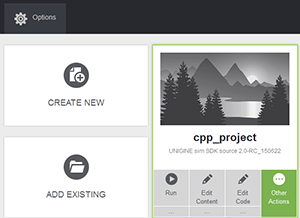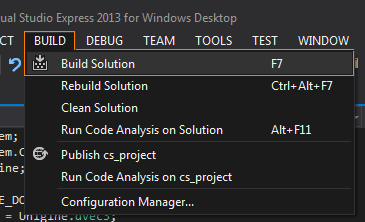Creating C++ Application
A Unigine-based application can be implemented by means of C++ only, without using UnigineScript.
This article describes how to add logic to your project by using the C++ language. Code written in C++ is the same for all supported platforms: Windows, Linux and OS X. The difference is in the way of compiling the project.
See also
- Articles in the Development for Different Platforms section to learn more on how to prepare the development environment, install the Unigine SDK and build the application for different platforms.
- Articles on Typical Architecture of a Unigine-Based Application and Engine Architecture for better understanding of the Unigine C++ API operation in the engine architecture.
- Examples located in the <UnigineSDK>/source/samples/Api and <UnigineSDK>/source/samples/App folders.
Creating Empty C++ Application
It is very easy to start your own C++ project by using UNIGINE SDK Browser:
- Open the UNIGINE SDK Browser.
- Go to the Projects tab and click CREATE NEW.

- Specify the following parameters:

- Project - specify the name of your project.
- Project Path - specify the path to your project folder.
- SDK - choose the Unigine SDK.
- API - here choose C++ to start working with the C++ API.
This parameter depends on a platform:
- On Windows you can create C++ Visual Studio 2010 or C++ Visual Studio 2013 project.
- On Linux you can create C++ GNU make project.
- On OS X you can create C++ Xcode project or C++ GNU make project.
- Architecture - specify the architecture of your target platform.
- Precision - specify the precision. In this example we will use double precision.
NoticeRead more about these parameters in this article - Click the Create New Project button. The project will appear in the projects list.

You can run your project by clicking the Run button.
Implementing C++ Logic
In this section we will add logic to the empty C++ application project.
The following example shows how to rotate the material ball that was created by default in your project.
-
If you created the C++ project for Visual Studio or Xcode:
- Choose your C++ project in the Unigine SDK Browser and click the Edit Code button to open the project in IDE.

If you created C++ GNU make project:
- On the created C++ project, click on the Other Actions button and then the Open Folder button.

 Other Actions buttonOpen Folder button
Other Actions buttonOpen Folder button - Go to the <YOUR PROJECT>\source\ folder and open the AppWorldLogic.cpp file with any plain text editor.
- Choose your C++ project in the Unigine SDK Browser and click the Edit Code button to open the project in IDE.
- Write (or copy) the following code in your project's AppWorldLogic.cpp file.
Source code (C++)
#include "AppWorldLogic.h" #include "UnigineEditor.h" #include "UnigineGame.h" using namespace Unigine; // define pointer to node NodePtr node; AppWorldLogic::AppWorldLogic() { } AppWorldLogic::~AppWorldLogic() { } int AppWorldLogic::init() { // get the material ball node Editor *editor = Editor::get(); node = editor->getNodeByName("material_ball"); return 1; } int AppWorldLogic::shutdown() { return 1; } int AppWorldLogic::destroy() { node.destroy(); return 1; } int AppWorldLogic::update() { // get the frame duration Game *game = Game::get(); float ifps = game->getIFps(); // set the angle of rotation double angle = ifps * 90.0f; // set the angle to the transformation matrix Unigine::Math::dmat4 transform = node->getTransform(); transform.setRotateZ(angle); // set new transformation to the node node->setTransform(node->getTransform() * transform); return 1; } int AppWorldLogic::render() { return 1; } int AppWorldLogic::flush() { return 1; } int AppWorldLogic::save(const Unigine::StreamPtr &stream) { UNIGINE_UNUSED(stream); return 1; } int AppWorldLogic::restore(const Unigine::StreamPtr &stream) { UNIGINE_UNUSED(stream); return 1; } -
If your use Visual Studio, do the following:
- Build your project by clicking Build -> Build Solution in Visual Studio or press F7.

- Start your project by clicking Debug -> Start in a proper mode in Visual Studio.

If you created the Xcode project:
- Build your project by clicking Product -> Build in Xcode.

- Run the project by clicking Product -> Run.

If you created GNU Make project:
- Execute the make command in the terminal to compile the application.
Shell commands
make - Launch the application by using the run script.
- Build your project by clicking Build -> Build Solution in Visual Studio or press F7.